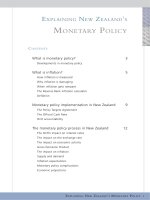Climate change policy and new zealand s national interest the need for embedding climate change policy into a sustainable development agenda
Bạn đang xem bản rút gọn của tài liệu. Xem và tải ngay bản đầy đủ của tài liệu tại đây (1.1 MB, 13 trang )
<span class="text_page_counter">Trang 1</span><div class="page_container" data-page="1">
Full Terms & Conditions of access and use can be found at
<b>Political Science</b>
<b>ISSN: 0032-3187 (Print) 2041-0611 (Online) Journal homepage: www.tandfonline.com/journals/rpnz20</b>
<b>Climate Change Policy and New Zealand’s‘National Interest’: the Need for EmbeddingClimate Change Policy Into a SustainableDevelopment Agenda</b>
<b>Ton Bührs</b>
<b>To cite this article: Ton Bührs (2008) Climate Change Policy and New Zealand’s ‘National</b>
Interest’: the Need for Embedding Climate Change Policy Into a Sustainable Development Agenda, Political Science, 60:1, 61-72, DOI: 10.1177/003231870806000106
<b>To link to this article: online: 02 May 2017.
Submit your article to this journal
Article views: 344
View related articles
</div><span class="text_page_counter">Trang 2</span><div class="page_container" data-page="2">’NATIONAL INTEREST’: THE NEED FOR EMBEDDING
TON BÜHRS
Ton <small>Bührs is a Senior Lecturer with the Environmental </small>Management Group, Society <small>and </small>Design Division, <small>Lincoln</small>
University, Canterbury, <small>New Zealand. Email: </small>
Abstract: In recent
times,
the New Zealandgovernment
haspublicly
strengthened
its commitment tocombating
climatechange by adopting
<small>a</small>range of
strategies,
ambitioustargets
and <small>an </small>emissionstrading
scheme.Moreover,
it hasproclaimed
<small>an </small>aspiration
for New Zealand to become the first’truly
sustainable’country
in the world. The article <small>assesses </small>these initiativesand claims
against
thebackground
of thegovernment’s performance
withregard
to thepromotion
of sustainabledevelopment which,
the author argues, has been weak. The <small>measures </small>adopted
to combat climatechange
<small>are </small>largely
of <small>a </small>technical and
managerial
nature and do not address theunderlying
<small>causes </small>of the wider environmental
problematique. Although
thepolicies adopted
mayhelp mitigate greenhouse
gasemissions, they
<small>are </small>likely
to fall short of the reductionsrequired. Furthermore,
<small>on </small>their own,they
will not set New Zealand <small>on </small>thepath
to become <small>a </small>’truly
sustainable’country; following
that
path
is <small>an </small>increasingly
difficult taskgiven
<small>a </small>globalised
economy and thecontinuing
dominance of the belief that infinite economicgrowth
is bothdesirable and
possible.
Keywords:
NewZealand,
climatechange policy,
sustainabledevelopment,
environmental space
As in many other
countries,
climatechange
has become <small>a </small>’first order’ issue <small>on </small>theagenda
of theNew Zealand
government.
Whilst therecognition
of climatechange
<small>as a </small>serious issue <small>can </small>be <small>seenas a </small>positive development,
it also poses risks. It is <small>not </small>just
that climatechange
tends <small>to </small>’crowd out’ other environmentalissues,
but that it becomes thedefining
issue for what the environmentalproblematique
is about. Thepredominant
response <small>to </small>climatechange,
also in NewZealand,
is based <small>on a narrow </small>interpretation
of what thechallenge
is:reducing greenhouse
gas(GHG)
emissions in the <small>most </small>cost-effective way.
Increasingly,
climatechange
isportrayed
<small>as a</small>(potentially) significant
economic threat. In line with thisview,
New Zealand’spolicy
response is circumscribedby
economicinterests,
often under the cloak of the ’national interest’. This responsecurtails the
integration,
of climatechange policy
into the broaderchallenge
of sustainabledevelopment,
whichimplies
andrequires addressing
environmentalissues,
and their economic and social <sub>causes, </sub>in <small>a more </small>comprehensive, meaningful
and effective ay.</div><span class="text_page_counter">Trang 3</span><div class="page_container" data-page="3">Although
I do <small>not </small>wish <small>to </small>deny
thatreducing greenhouse
gas emissions isimperative
<small>to</small>mitigate
the effects ofglobal warming,
<small>or </small>that it is wrong <small>to </small>do <small>so </small>in <small>a </small>cost-effective <small>manner, </small>I also think that it iscrucially important
<small>to </small>embed thisimperative
within <small>a </small>broader sustainabledevelopment agenda.
Notdoing
<small>so, or </small>doing
<small>so </small>inadequately,
carries the risk ofshifting, aggravating
<small>or </small>causing
<small>more </small>environmental and socialproblems
and undermines the effectivenessof climate
change policies.
Morefundamentally,
the <small>narrow </small>interpretation
of ’the climateproblem’,
and the focus <small>on </small>technological, managerial
and economic ’solutions’ forreducing
GHGemissions,
diverts attention from theunderlying
<small>causes, </small>drivers <small>or </small>factors that <small>are not </small>only responsible
for(rising) emissions,
but also for <small>a </small>raft of other environmentalproblems,
and for the unsustainablepath
the world is <small>on.</small>While the New Zealand
government
has made <sub>many </sub><small>statements </small>that indicate <small>a </small>commitment<small>to </small>
sustainability
and sustainabledevelopment,
these have <small>not </small>been translated into <small>an </small>operative
sustainable
development strategy
and/or intoadequate capacity building
fordeveloping
andimplementing
such <small>a </small>strategy.
Inpart,
this <small>can </small>be attributed <small>to </small>theprevailing interpretation
of thenotion of sustainable
development,
which is based <small>on </small>the convenientmyth
that economicgrowth
and environmental
sustainability
<small>are </small>compatible
<small>or even </small>complementary.
As <small>a </small>result,
environmental
problems, including
climatechange,
continue <small>to </small>be tackled in <small>a </small>largely
reactive andfragmented
manner, whilst theunderlying
factorsdriving
many of theseproblems
<small>are not </small>being
The main
argument
advanced in this paper is that the New Zealandgovernment’s
response <small>to</small>climate
change,
<small>even </small>if combined with similar responses of <small>most </small>othergovernments
in theworld,
may result in
lowering
GHGemissions,
but will <small>not </small>lead <small>to </small>sustainability,
neither in New Zealand<small>nor </small>the world <small>as a </small>whole. The
argument
<sup>will be </sup>supported by: first, describing,
ingeneral
terms,the <small>case </small>for
embedding
climatechange policy
into <small>a </small>broaderpolicy framework; second, describing
and
assessing
the New Zealandgovernment’s
climatechange policy
and the <small>extent to </small>which it is fitted within <small>a </small>broaderpolicy (sustainable development) framework;
andthird, discussing
<small>some </small>of theunderlying
issues and obstacles <small>to a more </small>integrated approach
that also addresses the <small>causes </small>ofThere is
increasing,
ifinadequate, recognition
that climatechange
is <small>one </small>of many environmentalproblems
thatrequire
<small>a more </small>comprehensive
andintegrated approach.
The main <small>reasons </small>fortaking
such <small>an </small>approach
<small>are: </small>the creation ofpolicy synergies, policy harmonisation,
and identification of <small>common causes.</small>’Policy synergies’
relate <small>to </small>the existenceof ’positive
externalities’ associated with <small>a course </small>of action. In this <small>case, measures to </small>combat climatechange
may havepositive
effects other thanhelping
<small>to </small>mitigate global warming,
whilepolicies
aimedprimarily
<small>at </small>issues other than climatechange
may also assist the <small>cause </small>oftackling
climatechange.
Thedevelopment
of <small>a </small>comprehensive policy
framework facilitates the identification ofpotential synergies
and enablesoptimal exploitation
of suchopportunities,
thuscontributing
<small>to </small>the enhancement of efficiencies in theachievement of
policy objectives. Examples
where climatechange policies
<small>can </small>contributepositively
to, and benefit from otherpolicies
<small>can </small>be found in theprotection
of forests andbiodiversity,
thepromotion
of energysecurity (by
<small>a </small>greater
reliance <small>on </small>local,
renewable <sub>energy</sub>resources),
theprotection
of land from erosion(by planting
<small>or </small>regeneration
ofvegetation),
the</div><span class="text_page_counter">Trang 4</span><div class="page_container" data-page="4">promotion
of healthier homes(by improving insulation), increasing
fuelefficiency (saving money),
andreducing
airpollution (by reducing
the <small>use </small>ofcoal, increasing
energyefficiency).2
<small>2</small>Policy
harmonisation refers <small>to </small>the need <small>to </small>reduce thepotentially
adverse effects(’negative
externalities’)
ofpolicies
<small>on </small>each other. For <small>a </small>start, theprimary objectives
of differentpolicies
may be in conflict with each other. Aspolicy development
almostalways
involvesdealing
withconflicting
views andinterests,
this isquite
<small>common </small>andprobably
<small>to some extent </small>inevitable. But it doespotentially
undermine the effectiveness ofpolicies
and therefore needs <small>to </small>be minimised. This is <small>a </small>political challenge
that may involvere-arranging priorities, amending policy objectives
<small>to</small>accommodate other <small>concerns or, more </small>
fundamentally, re-orienting
andre-designing
the <small>core </small>ofpolicies. Second,
<small>even </small>if theexplicit objectives
of differentpolicy
<small>areas </small>do <small>not seem to </small>be in conflict with eachother,
the <small>means </small>by
which thesepolicies
<small>are </small>implemented
may be. <sup>For </sup>instance,
financial-economic
policies
may <small>use </small>’tax cuts’ whileadvancing policy objectives
in other <small>areas</small> mayrequire
additionalgovernment spending
and <small>revenue. </small>The selection ofpolicy
instruments is <small>as</small>’political’
<small>as </small>the choice ofobjectives, making
it desirable <small>to </small>consider bothtogether
<small>across </small>thespectrum
ofpolicies.
The need for
policy
harmonisation is <sub>very </sub>apparent
withregard
<small>to </small>climatechange policy.
Energy, transport,
urbanplanning, industry, agriculture, trade, tourism, population
and economicpolicies
all affect GHG emissions.Many
of these otherpolicies
<small>are </small>drivenby
their <small>own </small>rationales,
which often include <small>a </small>commitment <small>to </small>
growth
andexpansion,
<small>an </small>objective
that has thepotential
<small>to</small>diminish <small>or even </small>
negate
thegains
achievedby
<small>a </small>climatechange policy.
On the otherhand,
climatechange policies
may have undesirable social andpolitical effects,
forinstance, by disproportionately burdening
the poor andincreasing inequity (by raising
theprice
ofpetrol, heating
and energy ingeneral).
Harmonisation is therefore <small>not </small>only
necessary <small>to </small>iron <small>out</small>differences between climate
change policy
and non-environmentalpolicies,
but also <small>to </small>reduce thepotential
that climatechange policies
will have adverse effects <small>on </small>other environmentalproblems
and
policies.
The
negative externality
effects of climatechange policy
may be less obvious than thepositive
externalities mentionedabove,
butthey
<small>can </small>besignificant.
Forinstance, tropical forests,
’scrubland’ <small>or areas </small>with
regenerating
forests may be cleared forplantation
forests <small>to </small>gain
carbon credits(with
adverse effects <small>on </small>biodiversity).3 Similarly,
many environmentalists would consider theadoption
<small>or </small>expansion
of nuclear powergeneration
<small>as </small>(part of)
<small>a </small>solution <small>to </small>reduce GHG emissionsenvironmentally unacceptable.’
Anotherexample
<small>can </small>be found ingenetic engineering
<small>to</small><small>create </small>
plants
that <small>are </small>better able <small>to </small>cope withchanging
climaticconditions,
but which have thepotential
<small>to create new </small>and seriousecological problems.5
Other innovative <small>means </small>aimed <small>at</small>tackling
climatechange
in isolation from other environmental issues <small>are </small>equally environmentally
David <sub>Jones, </sub>’Trading <small>for Climate without </small>Trading <small>Off on the Environment: An Australian </small>Perspective <small>on </small>Integration
<small>between Emissions </small>Trading <small>and Other Environmental </small>Objectives <small>and </small>Programs’, <small>Climate </small>Policy, Vol.3, <small>No. </small>Supplement <small>2</small>
(2003); <small>Rob </small>Swart, <small>John Robinson and Stewart </small>Cohen, <small>’Climate </small>Change <small>and Sustainable </small>Development: Expanding <small>the</small>
Options’, <small>Climate </small>Policy, <small>Vol. </small>3, <small>No. </small>Supplement <small>1 </small>(2003).
<small>This is a risk also identified for New Zealand. See Cath </small>Wallace, <small>’Emissions </small>Trading, Forestry, Agriculture <small>and</small>
Biodiversity’, <small>Ecolink. Newsletter </small>of the <small>Environment and Conservation </small>Organisations of New Zealand,
<small>No.October/November </small>(2007).
Although
<small>some </small>high profile <small>environmental advocates have embraced nuclear power, many environmentalists remain</small>sceptical <small>if not </small>outright opposed <small>to its </small>expansion, <small>because of the unresolved </small>safety <small>and waste </small>issues, <small>the </small>security (nuclear
proliferation) risks, <small>and because it is not </small>regarded <small>as a sustainable form of energy. Sarah </small>Barnett, <small>’Atomic </small>Dawn’, <small>NZ</small>
Listener, <small>Vol. </small>208, <small>No. 3492 </small>(2007); <small>Frank </small>Barnaby <small>and James </small>Kemp, <small>Too Hot to Handle? The Future </small>of Civil <small>NuclearPower London: Oxford Research </small>Group, (2007).
<small>Allison A. Snow and Pedro Morán </small>Palma, <small>’Commercialization </small>of Transgenic <small>Plants: Potential </small>Ecological Risks’,
BioScience, Vol.47, <small>No. </small>2 (1997); <small>Peter </small>Aldhous,’Genes <small>for </small>Greens’, <small>New </small>Scientist, Vo1.197, <small>No. 2637 </small>(2008), <small>pp. 28-31.</small>
Fred <sub>Pearce, </sub>’Cleaning Coal’, <small>New </small>Scientist, <small>Vol. </small>169, <small>No. 2649 </small>(2008),
</div><span class="text_page_counter">Trang 5</span><div class="page_container" data-page="5">installing
<small>a </small>space shield <small>to </small>mitigate global warming
and’fertilising’
<small>oceans to </small>promote
thegrowth
of
plankton
<small>to </small>absorbCO2,7
all of which aimed <small>at </small>avoiding
the need <small>to </small>reduce GHGemissions,
<small>are</small>examples
of’solutions’ that <sub>carry </sub>largely
unforeseeable risks.The identification of <small>common causes </small>refers <small>to </small>the existence of <small>common </small>factors <small>or </small>
driving
forces
underlying
<small>a </small>range ofproblems.
Much environmentalpolicy,
also in NewZealand,
has beendeveloped
in <small>a </small>fragmented
and reactive <sub>way, </sub>only
afterproblems
have becomeapparent
and seriousenough
<small>to </small>drawpolitical <sup>attention. </sup>Moreover,
<small>most </small>environmentalpolicies
have been aimed <small>at </small>mitigating
<small>or </small>adapting
to(coping with)
immediateproblems
rather thanaddressing underlying
<small>causes or </small>drivers. Climatechange policy is,
in thisrespect,
<small>no </small>different,
<small>as </small>I will discuss below.The notion of sustainable
development potentially provides
<small>a </small>cognitive
framework forcreating policy synergies, policy
harmonisation andidentifying
<small>common </small>underlying
<small>causes </small>of environmentalproblems.
Sustainabledevelopment
is <small>a </small>broad andslippery concept
that <small>can </small>beinterpreted
and used <small>to serve </small>different ends andinterests, including
economicgrowth. Commonly interpreted
<small>as </small>involving
<small>a </small>’balancing’
ofenvironmental,
social and economicinterests,
inpractice,
non-environmental interests. This has led <small>some </small>environmental advocates <small>to </small>
question
itsmeaningfulness
<small>or to </small>argue that it should beabandoned.9 However,
<small>as </small>theconcept
isalready firmly
entrenched in dominant environmental
discourse,
and has been institutionalised in many countries<small>as </small>well <small>as </small>
internationally,
this does <small>not seem a </small>realisticoption.
The main
promise
andsignificance
of the discourse ofsustainability
and sustainabledevelopment
lies in itspotential
<small>to </small>advance the’greening’
of non-environmentalpolicies
andinstitutions, notably by integrating procedural
and substantive’ecological rationality’’°
into the realms ofeconomics, industry,
energy,agriculture, transport,
andspatial planning,
which contain many of the <small>sources </small>anddriving
forces of environmentalproblems. However,
<small>to </small>promote
the<small>to </small> translate sustainable
development
intospecific objectives
and <small>courses </small> ofaction,
<small>a</small>comprehensive
andstrategic policy
framework isrequired.&dquo;
Sustainabledevelopment strategies,
national environmental
policy plans,
and national environmental actionplans
<small>are </small>just
<small>some </small>of the labels for suchpolicy
frameworks that have beenadopted by governments,
and for which‘green
planning’
has been used <small>as a </small>generic term.’2
Climatechange policy,
if it is <small>to </small>beeffective,
avoidsshifting
environmentalproblems
<small>or </small>creating
<small>new ones, </small>addressesunderlying
<small>causes </small>and,
<small>to</small>contribute <small>to </small>sustainable
development,
needs <small>to </small>be fitted within such <small>a </small>greenplanning
framework.Having outlined,
ingeneral
terms, the <small>case </small>forembedding
climatechange
in <small>a </small>broaderpolicy agenda
andframework,
I will <small>now </small>describe and <small>assess </small>New Zealand’s climatechange policy
<small>Mark </small>Townsend, <small>’Giant </small>Space <small>Shield Plan to Save </small>Planet’, <small>The </small>Observer, <small>11 </small>January 2004, <small>Available from</small>
<small>Emma </small>Green,’A Drop <small>in the </small>Ocean’, <small>New </small>Scientist,
<small>Vol. </small>195, <small>No. 2621 </small>(2007), <small>pp. 42-45.</small>
Ton <small>Bührs and Robert V. </small>Bartlett, <small>Environmental </small>Policy <small>in New Zealand. The Politics </small>of Clean <small>and Green? </small>(Auckland,
<small>N.Z.: Oxford </small>University Press, 1993).
<small>9 </small>
<small>Sharon </small>Beder, <small>’Revoltin’ </small>Developments. <small>The Politics of Sustainable </small>Development’, <small>Arena </small>Magazine, 1994); Lynton <small>Keith</small>
Caldwell, <small>Between Two Worlds: Science, the Environmental Movement, and </small>Policy <small>Choice </small>(Cambridge England; <small>NewYork: </small>Cambridge University Press, 1990), <small>p. 177.</small>
D. <small>B. </small>Dalal-Clayton, Getting <small>to </small>Grips <small>with Green Plans: National-Level </small>Experience <small>in Industrial Countries </small>(London:
Earthscan, 1996); <small>Martin Jänicke and </small>Helge Jörgens, <small>’National Environmental </small>Policy Planning: Preliminary <small>Lessons fromCross-National </small>Comparisons’, <small>Environmental </small>Politics, Vol.7, <small>No. </small>2 (1998).
</div><span class="text_page_counter">Trang 6</span><div class="page_container" data-page="6">NEW ZEALAND’S RESPONSE TO CLIMATE CHANGE
Although
New Zealand has ratified theKyoto Protocol,
and has bound itself <small>to </small>reducing
GHGemissions <small>to </small>1990 levels
by 2012,
it has neither been very forceful <small>nor </small>effective intackling
this task. Thusfar, governments
have relied almostexclusively
<small>on </small>voluntary
and informational instruments and have shied <sub>away </sub>fromadopting regulation
and economic <small>measures. </small>As <small>a </small>result,
Only recently,
in the wake of the international <sub>surge </sub>in <small>concern </small>about climatechange,
thegovernment
launched <small>a </small>range of <small>new </small>initiatives aimed <small>at </small>tackling
climatechange,
and reaffirmed its commitmentby setting
<small>some </small>ambitiousobjectives
andtargets.
One of the maincomponents
of this <small>more </small>vigorous approach
is the New ZealandEnergy Strategy (NZES) 14
which containstargets
for renewable
electricity generation (90 percent by 2025)
and forhalving
percapita
emissions fromtransport by 2040,
and which introduces <small>a </small>minimum biofuels salesobligation.
Thecompanion
<small>to </small>thisdocument,
the <small>new </small>’Energy Efficiency
and ConservationStrategy’ (EECS), 15
<small>sets out a </small>range of <small>measures </small>that also have the
potential
<small>to </small>mitigate
GHG emissions. Three otherstrategies, adopted earlier,
<small>a </small>wastestrategy,’6
sustainable landmanagement strategy&dquo;,
and <small>a</small>lynchpin
of these efforts isarguably
theadoption,
inprinciple,
of <small>an </small>emissionstrading
scheme(ETS)’9
that will becovering
allgreenhouse
gases and sectors from 2013.The New Zealand
government
has been keen <small>to </small>emphasise
that its climatechange
efforts <small>are</small>image (if
<small>not </small>status)
<small>as a </small>’clean andgreen’ country.
Prime Minister Helen Clark in <small>a </small>speech
<small>to a</small>Labour
Party
conference said:Why
shouldn’t New Zealand aim <small>to </small>be the firstcountry
which istruly
sustainable<small>-not </small>
by sacrificing
<small>our </small>living standards,
butby being
<small>smart </small>and determined? We <small>cannow move to </small>develop
<small>more </small>renewable energy,biofuels, public transport
alternatives,
andminimise,
if <small>not </small>eliminate,
<small>waste to </small>landfills. We could aim <small>to </small>be carbon neutral. I believe thatsustainability
will be <small>a core </small>value in 21stcentury
social
democracy.
I <small>want </small>New Zealand <small>to </small>be in thevanguard
ofmaking
ithappen
-for <small>our own </small>
sakes,
and for the sake of <small>our </small>planet.
I <small>want </small>sustainability
<small>to </small>be central<small>to </small>New Zealand’s
unique
nationalidentity.20
<small>across a </small>range of <small>areas, </small>and may lead <small>to a </small>
mitigation
of GHGemissions,
there <small>are </small>good grounds
for
arguing
that New Zealand’s climatechange
efforts <small>are </small>notsquarely placed
<small>on a </small>sustainabledevelopment agenda,
<small>or </small>that,
ifthey
are, thegovernment’s interpretation
of sustainabledevelopment
is ratherpeculiar,
circumscribed <small>more </small>by
economic thanby
environmental <small>concerns</small><small>New Zealand </small>Government, <small>New Zealand </small>Energy Efficiency <small>and Conservation </small>Strategy - Making <small>It </small>Happen (Wellington:
Energy Efficiency <small>and Conservation </small>Authority, 2007).
Ministry <small>for the </small>Environment, <small>New Zealand Waste </small>Strategy (Wellington: Ministry <small>for the </small>Environment, 2002). 17
New <small>Zealand. </small>Ministry <small>for the </small>Environment., <small>Sustainable Land </small>Management : <small>A </small>Strategy for <small>New Zealand </small>(Wellington,
<small>N.Z.: </small>Ministry <small>for the </small>Environment, 1996).
</div><span class="text_page_counter">Trang 7</span><div class="page_container" data-page="7">First of
all,
New Zealandcurrently
has <small>no </small>explicit
sustainabledevelopment strategy.
Although
several efforts towards thedevelopment
of <small>a </small>broader environmental and sustainabledevelopment strategy
have beenundertaken,
both of these have been abandoned. In1995,
the National Governmentadopted
the ’Environment 2010Strategy’,
but this <small>was </small>discarded when the Fifth Labour Government <small>came to </small>power in 1999. In2003,
the Labourgovernment
introduced’Sustainable
Development
for New Zealand:Programme
ofAction’,
but this <small>was </small>discontinued in2006.
Consequently,
New Zealand does <small>not </small>have <small>a current </small>sustainabledevelopment strategy
<small>or </small>any othercomprehensive
andstrategic
environmentalpolicy.
In thisrespect,
it <small>can </small>beargued
that New Zealand isformally
in breach of its international commitment <small>to </small>adopt
andimplement
such <small>a</small>towards the
development
of <small>a </small>comprehensive
andstrategic policy
framework. The Environment 2010Strategy provided
<small>an </small>inventory
of environmentalproblems facing
New Zealand but:is
only strategic
in <small>a </small>limited <small>sense: </small>important problems
<small>are </small>identified andgoals
<small>are</small>formulated,
but these <small>are as </small>yet hardly prioritised and,
<small>more </small>significantly,
<small>are not</small>based <small>on an </small>
analysis
of where theseproblems
<small>are </small>coming
from(no
theoretical framework and identification ofkey
factors <small>or </small>variables that <small>can </small>bemanipulated
<small>to</small>address these
problems
<small>most </small>effectively). 22
The
Programme
of Action <small>was even </small>lesscomprehensive
in its <sub>coverage of </sub>environmental issues and focused <small>on </small>just
four issues: water, energy, sustainablecities,
and child andyouth
development.23
While this <small>can </small>be <small>seen a </small>deliberate <small>move </small>towards <small>a more </small>targeted approach,
it still falls far short <small>on a </small>number of criteria for effectivestrategic
environmentalpolicy, especially
with
regard
<small>to </small>comprehensiveness, strategic analysis,
andpublic involvement.24 Although
<small>some</small>reviewers considered that the
programme’s significance lay
in its ’actionlearning’ approach
rather than its substance <small>or </small>
outcomes,25
its discontinuation <small>seems to </small>indicate that <small>no more</small>learning
isrequired,
whilst it remains unclear what lessons thegovernment
has learned from theexperience. Implicitly,
the lack of <small>a </small>follow upstrategy,
<small>or even an announcement to </small>thateffect,
<small>seems to </small>re-confirm the
Parliamentary
Commissioner for the Environment’s(PCE)
assessment,has been slow in New Zealand
compared
with many other OECDcountries. 26
The lack of
government support
for thedevelopment
of <small>an </small>overarching policy
framework that has sustainabledevelopment
<small>at </small>its <small>core </small>is also reflected in the lack of action withregard
<small>to</small>strengthening
New Zealand’scapacity
andleadership
for sustainabledevelopment.
The Office of the Prime Minister has been theleading
agency <sup>behind </sup>theProgramme
ofAction,
but thedevelopment
andongoing
review of such <small>a </small>strategy
is <small>not </small>the main <small>or even a core </small>responsibility
of that <sub>agency. </sub>Given thestrong
exposure of that office <small>to </small>thevagaries
of(party) politics,
it is alsoWendy <small>McGuinness and Ella </small>Lawton, A<small>National Sustainable </small>Development Strategy: <small>How New Zealand Measures up</small>
against <small>International Commitments </small>(Wellington: <small>Sustainable </small>Future, 2007), <small>p. 2.</small>
<small>Ton Bührs and Robert V. </small>Bartlett, ’Strategic Thinking <small>and the Environment: </small>Planning <small>the Future in New </small>Zealand?’,
<small>Environmental </small>Politics, <small>Vol. </small>6, <small>No. </small>2 (1997), <small>p. 97.</small>
<small>New Zealand </small>Government, <small>Sustainable </small>Development for <small>New Zealand: </small>Programme ofAction (Wellington: Department
<small>of Prime Minister and </small>Cabinet, 2003).
<small>Ton </small>Bührs, <small>’New Zealand’s </small>Capacity <small>for Green </small>Planning: <small>A Political-Institutional Assessment and </small>Analysis’, <small>Political</small>
Science, <small>Vol. </small>54, <small>No. </small>1 (2002), <small>pp. </small>29-30; <small>McGuinness and </small>Lawton, A <small>National Sustainable </small>Development Strategy: <small>HowNew Zealand Measures up </small>against <small>International </small>Commitments, <small>p. 22.</small>
<small>Bo Frame and Maurice </small>Marquardt, <small>Indications </small>of the <small>Sustainable </small>Development Programme of Action (Lincoln: <small>Landcare</small>
Research, 2006).
Parliamentary <small>Commissioner for the </small>Environment, Creating <small>Our Future: Sustainable </small>Development for <small>New Zealand</small>
(Wellington: <small>Office of the </small>Parliamentary <small>Commissioner for the </small>Environment, 2002), 9, <small>15.</small>
</div><span class="text_page_counter">Trang 8</span><div class="page_container" data-page="8">horizon,
and broadsupport
basis that <small>are </small>required
for such <small>an </small>undertaking. Similarly,
the role andcapacity
of theMinistry
for the Environment hasproved
<small>to </small>be vulnerable in thisrespect.
Nor is it <small>a</small>clear
responsibility
of <sub>any </sub>other office. Forexample,
while the PCE has been <small>an </small>advocate for sustainabledevelopment,
that office has <small>no </small>formalresponsibility
for thedevelopment, implementation
<small>or </small>monitoring
of <small>a </small>sustainabledevelopment strategy,
and <small>not </small>enough capacity
fordoing
<small>so.</small>In <small>terms </small>of
legislative capacity,
New Zealand’s ResourceManagement
Act has sustainableand
unclear, especially
inlight
of differences ininterpretation
andimplementation,
the <small></small>non-existence of <small>a </small>consistent <small>set </small>of criteria for <sub>assessment, </sub>and the absence of
systematic
<small>outcome</small>evaluation.&dquo; <sub>Overall, </sub>
New Zealand’s national-levelcapacity
for’green planning’,
and for that<small>matter </small>the
development
oflong-term policy
of anykind,
isseverely lacking.28
Thusfar,
calls forstrengthening it,
such <small>as </small>by creating
<small>an </small>advisory body
with the task <small>to </small>advance the sustainabledevelopment agenda ’29
appear <small>to </small>have fallen in deaf <small>ears.</small>Perhaps
<small>most </small>worryingly
ofall,
<small>a </small>closescrutiny
of both these <sub>recent, half-hearted </sub>attempts
<small>to</small>develop
<small>a </small>long-term
environmental <small>or </small>sustainabledevelopment strategy suggest
that the main rationale for theadoption
of thesustainability
discourseby
thegovernment
has <small>more to </small>do with economic than with environmental <small>concerns. </small>Seen in the <small>context </small>of thegovernment’s
widerstrategic
efforts andpriorities,
the <small>status </small>of the Environment 2010Strategy,
and theobjectives
itcontained, appeared subsidiary
<small>to </small>economicgoals
andpriorities.
Thestrategy
referred <small>to </small>theimportance
of the health of theenvironment,
<small>as </small>well <small>as </small>people,
for economicgrowth.3°
TheProgramme
of Action also refers <small>to </small>economic ’health’ <small>as </small>thegovernment’s
maingoal: ’[t]he
sustainable economic
growth. 31
Morespecifically,
the <sub>programme </sub>identifiedreturning
New Zealand’s <sub>per </sub>capita
income <small>to </small>thetop
half of the OECDrankings
andmaintaining
thatstanding
<small>asone </small>of itsmajor
economicobjectives.32
This led the PCE <small>to </small>the observation that <small>an </small>analysis
of thepriority [...]
whenkey
decisions <small>are </small>being made.’33
Given that the
government’s
foremostpriority
is economicgrowth,
andgiven
New Zealand’s <small>s</small>heavy
reliance <small>on </small>exports
from theprimary
sector(accounting
for about two-thirds ofexport
value),34
it isprobably
<small>not </small>surprising
that theprotection
of the economic interests of this <small>sector </small>is considered <small>to </small>be in the ’nationalinterest’,
and that climatechange policy
is embedded within thisinterpretation
of the national interest. Thegovernment
<small>notes </small>that:Much of <small>our </small>economy is based <small>on </small>
biological
industries. We are distant from markets and customers,including
<small>our </small>tourism markets. Ourtopography
and lowIbid, <small>pp. </small>9, 93-96., <small>Peter Skelton and Ali </small>Memon,’Adopting Sustainability <small>as an </small>Overarching <small>Environmental </small>Policy: <small>AReview of Section 5 of the </small>RMA’, <small>Resource </small>Management Journal, <small>Vol. </small>X, <small>No. </small>1 (2002).
<small>Bührs and </small>Bartlett, ’Strategic Thinking <small>and the Environment: </small>Planning <small>the Future in New Zealand?’ Environmental</small>
Politics, <small>Vol. </small>6, <small>No. </small>2 (1997), <small>p. 96.</small>
<small>New Zealand </small>Department <small>of the Prime Minister and </small>Cabinet, <small>Sustainable </small>Development for <small>New Zealand: </small>Programme of
<small>Action </small>([Wellington, N.Z.]: Department <small>of Prime Minister and </small>Cabinet, 2003), <small>p. 10.</small>
</div><span class="text_page_counter">Trang 9</span><div class="page_container" data-page="9">population deny
<small>us </small>options
other societiesenjoy.
Our <sub>response </sub><small>to </small>climatechange
<small>must </small>reflect <small>our own </small>
particular
nationalcircumstances,
and be directed towardsNew Zealand’s
interests,
<small>as </small>well <small>as </small>global solutions
Thus,
economic interestslargely
circumscribe New Zealand’s climatechange policy
in the selection of technical ‘solutions’ andpolicy options.
Protection of thecountry’s
economic interests also informs its international <small>stance on </small>the issue. Rather thanbeing
embedded in <small>a </small>sustainabledevelopment framework,
New Zealand’sapproach
<small>to </small>climatechange
is in fact embedded in <small>an</small>economic
policy
framework thatprescribes
<small>a </small>narrow,technological, managerial
and economicinterpretation
of ’the climateproblem’
andignores
wider issues and factors that underlie climatechange
<small>as </small>well <small>as </small>other environmentalproblems.
Effectively addressing
climatechange requires
thedevelopment
of <small>an </small>overarching policy
framework which
recognises
the links between environmentalproblems,
but that also addresses theunderlying
<small>causes or </small>drivers. Itrequires looking
behind theproximate
<small>causes </small>of GHGemissions,
such <small>as </small>energygeneration
andtransport,
<small>to </small>the ’drivers’ of thecontinuously growing
and
newly generated
environmental pressures andproblems. Ultimately,
it will beargued below,
the <small>sources </small>of the environmental
problematique
lie in the dominantpolitical-economic
andsocio-cultural
systems.
Although
climatechange
may have become the <small>most </small>prominent
environmentalproblem
<small>on</small>the
political agenda,
it is <small>not </small>theonly
<small>one </small>that has beensteadily eroding
the material basis forhuman well
being, locally, regionally
<small>or </small>globally.
Recent <small>assessments </small>of theglobal
<small>state </small>of the environment indicate <small>a </small>rapid
decline ofbiodiversity (an
indicator of the health ofecosystems,
andnotably
the loss oftropical
rainforests), growing
<small>water </small>scarcity
in manyparts
of theworld,
continued loss of
agricultural land, continuing
andincreasing pollution
in manyparts
of theworld,
and <small>an </small>
emerging scarcity
of <small>a </small>range of mineral <small>resources, </small>particularly oi1.36
At the <small>same </small>time,
world
population
isexpected
<small>to </small>grow <small>to </small>around 9 billionpeople by 2050,
while continued economicgrowth
fuels <small>a </small>growing
demand for <small>resources. </small>Theseglobal
trends have revived the debate about ’environmentallimits.37
that <small>was </small>pushed
into thebackground during
the 1980s with the decline ofcommodity prices (including oil),
and the rise <small>to </small>prominence
of the sustainabledevelopment discourse,
whichpromoted
the ideathat
economicgrowth
and environmentalprotection
<small>are </small>complementary.
This renewed focus <small>on </small>environmental limits is <small>not </small>foremost based<small>on </small>the absolute
scarcity
of <sub>resources, </sub>but <small>on </small>the environmental effects associated with thegrowing ’throughput’
of <sub>energy </sub>andmaterials,
of which climatechange
isjust
<small>one, </small>(albeit significant), example. 38
While the environmental limits <small>are </small>
increasingly apparent,
the obstacles <small>to </small>recognising
them<small>are </small>still <small>enormous. </small>
Governments,
businesses and <small>most </small>individuals continue <small>to </small>believe in the<small>New Zealand </small>Government, <small>A New Zealand Emissions </small>Trading <small>Scheme: </small>Key Messages <small>and </small>Strategic Issues, p. 4.
<small>Millennium </small>Ecosystem Assessment, <small>’Millennium </small>Ecosystem <small>Assessment </small>Synthesis Report. <small>Pre-Publication Final Draft</small>
Approved by <small>Ma Board on March </small>23, 2005’, (Accessed: <small>2 </small>April 2005); <small>United Nations Environment </small>Programme, <small>GlobalEnvironmental Outlook 4. </small>Environment for Development (Nairobi: <small>United Nations Environment </small>Programme, 2007).
<small>Donella H. </small>Meadows, <small>Dennis L. </small>Meadows, Jörgen Randers, <small>William W. </small>Behrens, <small>The Limits to Growth. A </small>Report for <small>theClub </small>of Rome’s Project <small>on the Predicament </small>of Mankind (New <small>York: New American </small>Library, by arrangement <small>with Universe</small>
Books, 1972); <small>Donella H. </small>Meadows, Jørgen Randers, <small>Dennis L. Meadows and Donella H. </small>Meadows, <small>Limits to Growth: The30-Year </small>Update (London: Earthscan, 2005).
<small>Dennis </small>Pirages, ’From <small>Limits to Growth to </small>Ecological Security’, <small>in Dennis and Ken Cousins </small>Pirages (ed.), <small>FromResource </small>Scarcity <small>to </small>Ecological Security: Exploring <small>New Limits to Growth </small>(Cambridge, <small>Mass.: MIT </small>Press, 2005); Ralph’
<small>David </small>Simpson, <small>Michael A. Toman and Robert U. </small>Ayres, <small>’Introduction: The "New </small>Scarcity"’, <small>in </small>Ralph <small>David </small>Simpson,
<small>Michael A. Toman and Robert U. </small>Ayres (eds.), Scarcity <small>and Growth Revisited: Natural Resources and the Environment inthe New Millennium </small>(Washington <small>D.C.: Resources for the </small>Future, 2005).
</div><span class="text_page_counter">Trang 10</span><div class="page_container" data-page="10">convenient
myth
that economicgrowth
and environmentalprotection
<small>are </small>compatible
<small>or even</small>complementary.
While this <small>can </small>be <small>true as </small>long
<small>as </small>economicgrowth
ismainly
of <small>a </small>monetary (value)
nature, the
reality
isthat,
thusfar,
economicgrowth
has been based <small>on or </small>accompanied by
<small>an</small>increase in material
’throughput’
andgrowing
<small>resource </small>consumption,
and thusgrowing
environmental <sub>pressures.</sub>
Reducing
environmental <sub>pressures while </sub>achieving
economicgrowth (measured
inmonetary
terms, likeGDP)
is referred <small>to as </small>’absolutedecoupling’.
Relativedecoupling
<small>means an </small>increase of environmental <sub>pressure, </sub>but <small>at a </small>lowerpercentage
<small>rate </small>than the <small>rate </small>of economicgrowth.
In <small>some</small>countries,
there has been <small>an </small>’absolutedecoupling’
between economicgrowth
and <small>some </small>emissions,
achieved <small>a </small>
degree
of relativedecoupling
in the <small>use </small>of <sub>energy </sub>(’energy intensity’
ofGDP)
and other<small>resources, </small>it is <small>not </small>evident that this has led <small>to a </small>decline in environmental pressures, <small>as </small>absolute levels of <small>resource use </small>have <small>not </small>
decreased . 40
In several <small>areas </small>(notably
energy andtransport),
efficiency gains
have been <small>more </small>than offsetby
<small>an </small>increase indemand,
inpart
because of <small>a</small>’rebound effect’ and because of economic
growth .4
Also in NewZealand,
there is <small>no </small>sign
of <small>a</small>decline in the demand for <small>resources, </small>
including
energy, <small>even </small>though
<small>more </small>recently
there has been<small>some </small>
improvement
in energyintensity.42
TheEuropean
EnvironmentAgency
concludes that‘[e]co-efficiency improvements
inkey production
<small>sectors are </small>typically
<small>more </small>than offsetby growth
in
consumption.
Meanwhile <small>consumers </small>show littlesign
ofshifting spending
<small>to </small>less pressure intensivetypes
ofgoods/services.’
<sup>43</sup>The
challenge
<small>to </small>decouple
economicgrowth
isdaunting, especially
in <small>a </small>globalised
economy. Tobring
about absolutedecoupling,
<small>resource </small>efficiency gains
would need <small>to </small>increase worldwide <small>at</small><small>more </small>than <small>at </small>the
exponential
<small>rate </small>ofglobal
economicgrowth,
which stood <small>at an </small>average of threeadvanced countries
struggle
<small>to </small>achievethis.45
Given the resource-based <small>nature </small>of its economy and much of itsexports,
absolutedecoupling
poses <small>an even more </small>formidablechallenge
<small>to </small>New Zealand.Many
rich countries have achieved <small>some </small>improvement
of environmentalperformance,
<small>at</small>least in
part, by shifting
<small>some </small>of the <small>more resource </small>intensive andpolluting
industries <small>to </small>poorercountries,
andby increasing imports.
’International trade ... leads <small>to </small>theshifting
of environmental burdens from the <small>consumer </small>countriesabroad.’ 46 <sub>By </sub><sub>promoting </sub>
freetrade,
<small>as </small>exemplifiedby
theEuropean <small>Environment </small>Agency, <small>Air Pollution in </small>Europe <small>1990 -2004 </small>(Luxembourg: <small>Office for Official Publication of the</small>
European Communities, 2007).
European <small>Environment </small>Agency, <small>Sustainable Use and </small>Management of Natural <small>Resources </small>(Luxembourg: <small>Office forOfficial Publication of the </small>European Communities, 2005), <small>p. 15.United Nations Environment </small>Programme, <small>GlobalEnvironmental Outlook 4. </small>Environment for Development, <small>p. 46.</small>
<small>The ’rebound’ effect </small>(also <small>referred to as the Jevons </small>Paradox) <small>refers to the rise in </small>consumption <small>as it becomes </small>cheaper <small>to</small>
<small>use a resource as a result of </small>efficiency gains. <small>For </small>instance, <small>as cars get more </small>fuel-efficient, people <small>tend to drive more, and</small>
electricity <small>use goes up with the sale </small>of ’energy <small>efficient’ heat pumps. </small>European <small>Environment </small>Agency, Europe’s
<small>Environment. The Fourth Assessment. Executive </small>Summary (Luxembourg: <small>Office for Official Publication of the </small>European
Communities, 2007), <small>pp. 252-289. The </small>Press, ’Cooling <small>Use of Heat </small>Pump Concerns’, <small>March 29 2008.</small>
Energy Efficiency <small>and Conservation </small>Authority (EECA), <small>’Situation Assessment </small>Report <small>on the National </small>Energy Efficiency
<small>and Conservation </small>Strategy’, (Accessed: <small>12 </small>April 2006).
European <small>Environment </small>Agency, <small>Environmental </small>Pressures from European Consumption <small>and Production. </small>Insights from
<small>Environmental Accounts </small>(Copenhagen: European <small>Environment </small>Agency, 2007).
European <small>Environment </small>Agency, <small>Environmental </small>Pressures from European Consumption <small>and </small>Production, <small>p. 12.</small>
<small>John </small>Hille, <small>The </small>Concept of Environmental Space. Implications for <small>Policies, Environmental </small>Reporting <small>and Assessments</small>
(Copenhagen: European <small>Environment </small>Agency, 1997), <small>p. </small>17; <small>United Nations Environment </small>Programme, <small>GlobalEnvironmental Outlook 4. </small>Environment for Development, <small>p. 213.</small>
European <small>Environment </small>Agency, Europe’s <small>Environment. The Fourth Assessment. Executive </small>Summary, <small>p. </small>260; <small>UnitedNations Environment </small>Programme, <small>Global Environmental Outlook 4. </small>Environment for Development, 196, 289.
</div>








